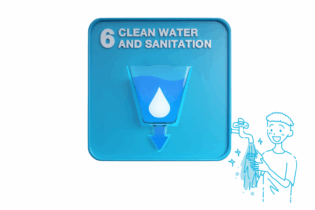Water from coal may sound impossible but happens every day. By Susan Cole, regional commercial manager sub-Saharan Africa, Dow Water & Process Solutions
Each day in north-eastern South Africa, an award-winning water reclamation plant turns conventional wisdom on its head and supplies up to 30 Mℓ day of potable water. Considering a person must consume about two litres of water a day to live healthily, 30 Mℓ is enough daily drinking water for up to 15 million people. Since 2007, the eMalahleni Water Reclamation Plant, situated in the Witbank coal fields of South Africa’s Mpumalanga province, has desalinated rising underground water, from four major coal mines (one now defunct) into potable water; benefitting the local environment, alleviating serious operational challenges and meeting up to 20% of the local municipality’s daily requirements. A decade ago, commercial and municipal water partnerships like eMalahleni were rare. Today, many municipalities around the world are partnering with local industries to meet their common water needs. By doing so, municipalities and businesses reduce their capital and treatment costs, improve sustainability and meet ever-growing local residential and commercial water demands. Impetus for public-private water cooperationIn early 2008, United Nations Secretary-General Ban Ki-moon warned attendees at the World Economic Forum in Davos, Switzerland, that a rising global shortage of water resources could mean increased conflicts and fewer economic opportunities. “Population growth will make the problem worse,” he said, “so will climate change. As the global economy grows, so will its thirst. Many more conflicts lie just over the horizon.” In response to the Secretary-General’s speech, several large water-dependent companies, such as Coca-Cola, Nestlé and SABMiller, joined with international\ partner organisations such as the International Finance Corporation to form the Water Resources Group (WRG). The WRG is a unique public/private/civil society partnership that “helps government officials and other water sector specialists accelerate reforms that will ensure sustainable water resource management for long-term development and economic growth”. Key learnings in South Africa
That’s why private-public water partnerships such as eMalahleni are so valuable and illustrative of the challenges and opportunities available to locales that follow a similar path toward sustainability. To understand the success of the eMalahleni Water Reclamation Plant, it’s useful to understand where and why it was needed in the Witbank area. Located about 90 miles east of South Africa’s largest city, Johannesburg, the Witbank coal mines are in the Highveld plateau, the country’s most vital residential and commercial region.
Once filled with teeming grasslands over more than 150 000 m2 (an area the size of California), today the Highveld is South Africa’s most vital industrial, mining and farming region, and is home to the country’s largest concentration of cities. The Highveld’s meandering rivers supply much of the region’s fresh water and its peat-rich soil acts as a natural water filter for potable water. Still, the region struggles with its water supply.
Before the eMalahleni Water Reclamation Plant was built, the municipality of eMalahleni was regularly being fined for drawing more than its permissible quantity of water from the local dam. “We were drawing about 120 Mℓ of water a day, but our license only allowed us to draw 70 Mℓ and our people were drinking water with the animals,” said former eMalahleni Mayor Lina Malatjie, in a 2010 interview. Thus, the eMalahleni Local Municipality joined with Anglo Coal South Africa and BHP Billiton Energy Coal South Africa (BECS A) to collect and treat rising underground water from Anglo Coal’s Landau, Greenside and Kleinkopje mines, and BECS A’s defunct South Witbank mine. Rather than allowing polluted mine water to leach into the Highveld’s land and river system, the eMalahleni Water Reclamation Plant treats mine water using a dual-stage ultrafiltration membrane process. The result, according to Anglo Coal’s project manager, is treated water that’s purer and better than local surface or tap water.\ On average, the eMalahleni plant purifies 25 Mℓ of water each day, of which 16 Mℓ are supplied to the fast-growing eMalahleni Local Municipality. The remaining water is sufficient to meet the water supply needs of all of the area’s coal plants. Future plans call for expanding the water plant’s capacity from 30 Mℓ to 50 Mℓ of potable water daily. A collaborative standardTechnological advances in membrane and water treatment technology will go a long way toward benefitting regions of the world such as South Africa, which is expected to have a 17% supply/ demand gap by the year 2030, based on current usage levels. That’s why South Africa has created the Strategic Water Partners Network (SWPN), comprised of members such as those associated with the eMalahleni Water Reclamation Plant, to cooperatively find ways between government and private industry to improve water conservation, supply diversification and water quality. As evidenced by the initial success of the eMalahleni plant, the SWPN and South Africa are well on their way toward closing the water supply/ demand gap and creating a more sustainable water future for all users.








